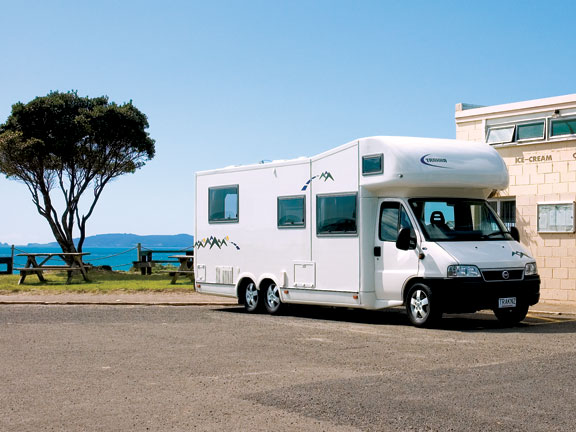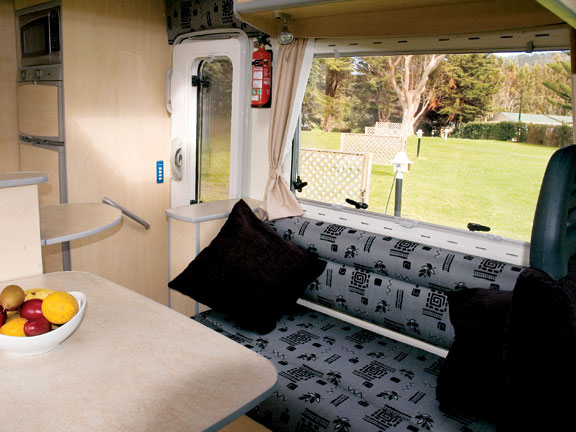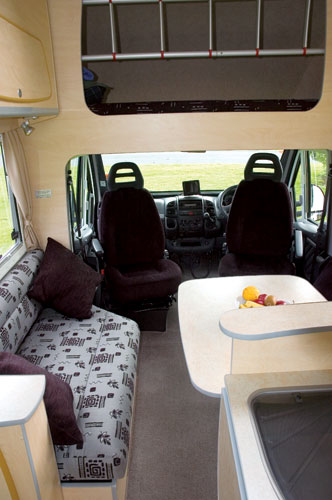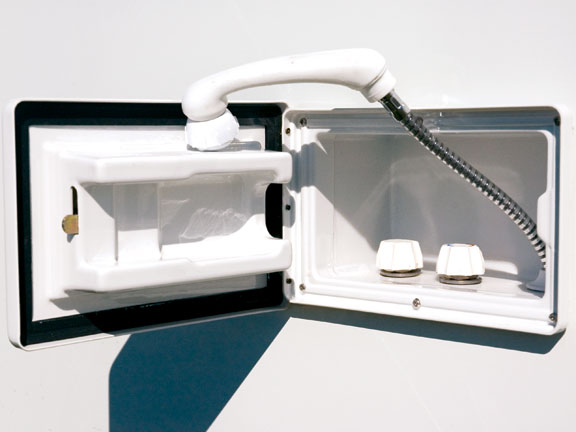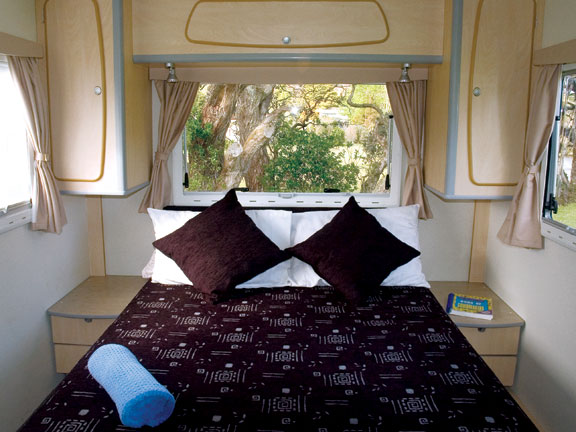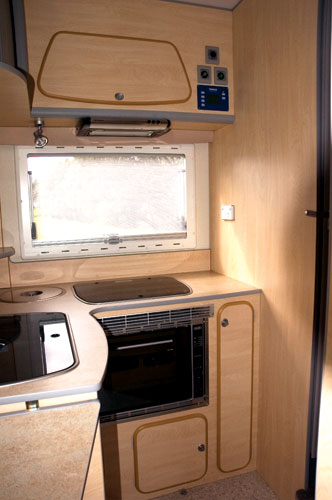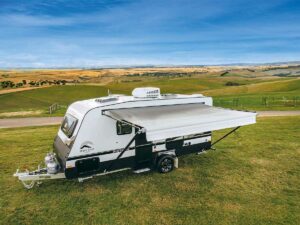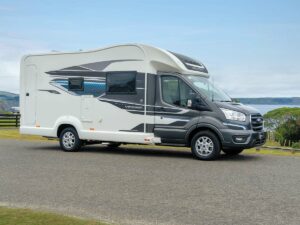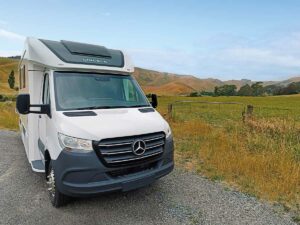In New Zealand, Trakka is a relatively new name in the motorhome world, but the company has had 30 years to hone their knowledge, which is evidenced by the products they are now putting on the road.
Motorhoming devotees will be familiar with the Torino and the Veneto – both of which are on Fiat Ducato bases and known for their well-appointed interiors. The Torino is the smaller, built on the LWB Ducato van. The Veneto 700 is built on a Fiat Ducato cab that is bolted to a lightweight Alko chassis with a lower centre of gravity, wider track, higher load capacity and independent suspension. The 820 has a similiar Alko chassis but has a tandem rear axle setup.
At the Hamilton Field Days earlier this year and then at the National Motor Home and Camping Expo in Christchurch in October, Trakka NZ presented the prototype of their next model, the eight-metre Trakkaway 820. It received such an enthusiastic response, production is now a certainty. The company says that the first Trakkaway 820 will be for general sale in July next year.
We were generously offered the use of this pre-production model to take away for a couple of days to test for ourselves. It raised the eyebrows of the campground manager in Hahei on the Coromandel: “Wow, what a beauty,” she said, and she is right.
From the outside the Trakkaway 820 is a long, sleek machine, eight metres in length and 2.4 metres wide. The body is moulded fiberglass with fully insulated walls, floor and ceiling. The finish is white high gloss and emblazoned with a stylised emblem of sun and hills.
The body of the prototype was built on a Fiat Ducato chassis with a 2.8-litre engine and five-speed gearbox. The production models will be updated to the new Fiat x250 specification, which includes the new 3-litre turbo diesel engine and a six-speed automatic transmission and will be slightly longer than the prototype at around 8.2metres. Hence the name Trakkaway 820.
We circled the vehicle, noting and admiring this and that. On the driver’s side of the vehicle are the lead storage locker and the gas locker for the two 9kg gas bottles. At the rear of the vehicle is the large boot, which extends under the double bed inside. On the passenger or kerb side of the vehicle there are three lockers: one for the toilet cassette, a larger one for the pullout stainless steel gas barbecue, and one which is alternative access to the boot locker. The home door is also on this side and it has a lengthy window that opens and a night-light inset above it. Beside this, between the door and the cassette locker, is an attachable table. There is also a sizeable Fiamma awning.
As to the interior, the immediate impression I had was one of homeliness, which in no way detracted from the feeling of space. Of course, in a vehicle this size there is plenty of space, but we really liked the way the living areas were divided off from one another for privacy. For instance, the bedroom at the back and the adjacent shower and bathroom can be closed off from the kitchen by a folding screen. And this division is further emphasised because the bedroom floor has been raised above the wheel arches to make space for the rear boot locker. The kitchen in the middle of the home is separated from the front lounge/dining area by a chest high divide.
But before I get to the ‘rooms’, here are some of the other general features that immediately enhanced the appeal of this motorhome: the well-placed heating vents, plenty of lights (both fluorescent and halogen) in the right places – even inside some of the lockers, and there’s nothing mean about the size or number of the windows (ten) or skylights (two). The windows are double-insulated and have effective screen/blind covers as well as curtains that add to the homeliness of the décor. The cabinetry throughout is made from honey-coloured lightweight Euro-ply.
The very roomy carpeted bedroom is at the rear of the van and I can personally vouch for the comfort of the permanently made-up, queen-size island bed and padded headrest. There’s a ton of storage. The bed lifts up so that the boot locker can be accessed from the inside, and there are also two sizeable drawers under the bed. On either side of the bed are lockers with handy laminate tabletops and above these, half-length wardrobes.
There is another long locker above the bed head and in one corner a tall cupboard with a smaller one for neat storage of the moveable LCD screen. This has mirrored doors, which I thought were a useful feature. Above this, on the ceiling, is the Winegard wind-up handle. Other thoughtful ideas were the two speakers unobtrusively placed high up in two corners, the ample light from the two halogen reading lights and a fluorescent ceiling light. The bedroom was one of the best I’ve seen in vehicle of this size.
The separate shower and bathroom are on either side of the ‘corridor’ leading from the bedroom. There’s a good-size shower and a Thetford swivel toilet with plenty of space around it so your knees don’t hit your ears when you sit down. The basin is adequate and there is a locker below it and a small cupboard above it that has mirrored doors. Both the bathroom and the shower have turbo extractor fans.
Two steps down and we were in the kitchen – convenient, roomy and efficient – but it doesn’t get quite as many ticks as the bedroom. The bench space is adequate (when is it ever enough – especially for a messy cook?) and there is an extension flap at one end, which is helpful. I liked the L-shaped layout with the three-hob stove below the window, a nifty Dometic extractor fan above it, and high up and to the right the easily reached control panel. The oven had a grill and rotisserie.
The sink and drainer were set into the bench next to the partition between the kitchen and the lounge. However, the Dometic glass lid over the sink wouldn’t stay open because it hit the ledge of the divide. This was a nuisance. I mentioned it to Trakka’s director Dave Berry, who said that this would be corrected in the production models.
A rubbish bin had been set into the bench which, as chief cook, I found really convenient. But I stowed the lid while travelling because I thought it could become a lethal missile if we (heaven forbid) bumped into something. It was easy enough to stow but Dave said that in the production models a hinged lid would probably be fitted.
The 175-litre Dometic fridge/freezer is next to the entrance, opposite the stove. Above that is the microwave and above again, a storage cupboard. There is good storage in the kitchen but a couple of the cupboards would be difficult to reach for the even slightly vertically challenged.
The lounge/dining area (also carpeted) is one step up from the kitchen level. It comprises comfortably upholstered bench seats on either side of a large table. The pedestal table is an excellent size and I thought its multipositional function was a great idea. Even so, I would be inclined to take it down and stow it when not in use as it makes the lounge area a tad cramped to move around in.
The driver and passenger seats are both on swivel bases, which brings the seating in the lounge area up to six. Both bench seats can be raised to access good storage underneath them, and in the one on the driver’s side the two house-batteries are stored. Beside the outside door is a utility locker – a good feature that is handy for all sorts of things including shoes.
The walkway from the lounge to the cab is a good size but I kept hitting my head on the edge of the cutout, as it was lower than I expected it to be. I have to say that this was more a design fault of the end user than the product. I’m a slow learner but after two days I was remembering to duck. The standard 820, however, will come with a hinged luton mattress which can be elevated to allow a walk-in cab.
The cab has all the Fiat Ducato’s bells and whistles (we have our own so they were familiar) but it’s worth pointing out the double air bags, backing camera with sound and the suspension adjuster pad. One feature which I thought excellent was the concertina blinds that have been shaped to cover the side and front windows of the cab at night.
The insulated luton above the cab was surprisingly roomy with small windows and a halogen light at either end and an aluminium ladder for access. I don’t go for sleeping in lutons much but I think I would have been fine in this one.
As to the actual driving, we give the Trakkaway 820 a very big tick. And here is the real surprise. With careful packing, the motorhome (tare weight four tonnes) will be under four and a half tonnes, which means it is the only eight-metre motorhome in Australasia than can be driven on a car licence. I don’t have an HT licence and I have never before driven anything of this bulk.
I climbed into the driver’s seat with the dry mouth and sweaty palms that I imagine a first-time Boeing jet pilot might have. In fact, driving it was incredibly easy and not at all stressful; so much so that it would have been easy to forget the size of the vehicle behind me. Bill, who’s had a lot of big vehicle driving experience, was also very impressed with Trakkaway’s good road manners. He remarked on its stability and balance, how easy it was to manouevre and back, and how well it handled a turn in tight situations.
To give it a good work out we took it over Black Jack on the Coromandel, which is a notoriously winding, hilly and unsealed bit of road on the Coromandel. Here again the Trakkaway performed well. On long or steep hills the vehicle noticeably slowed but the three-litre engines in the production models will make quite a difference.
I’m not at all surprised that the Trakkaway 820 has impressed those who’ve seen it. After two days of actually living in it we had to wrestle with our conscience in order to take it back.
The Trakka concept was to build a large motorhome offering separate living and kitchen areas, bathroom and bedroom on a vehicle with easy car-like driving manners that could legally be driven on a normal car license and would be economical to run. The Trakkaway 820 will be supplied with ADR approval, which means it will comply with all the local (NZ and OZ) standards for gas, electricity and LTS.
The vehicle we took away was sold shortly after we returned it, which bodes well for the model’s future.
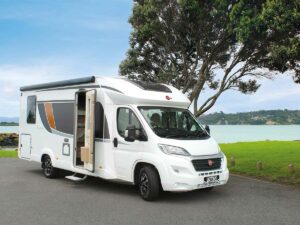
Review: Bürstner Lyseo IT744 Harmony Line
An elegant experience inside and out, the Bürstner Lyseo IT744 makes the most of its dimensions.

